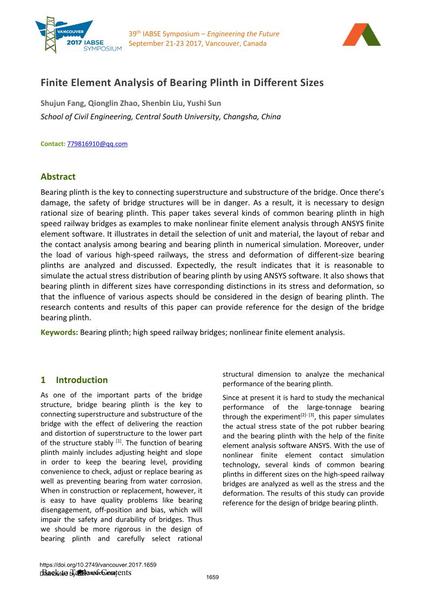Finite Element Analysis of Bearing Plinth in Different Sizes

|
|
|||||||||||
Bibliographic Details
| Author(s): |
Fang Shujun
(School of Civil Engineering, Central South University, Changsha, China)
Zhao Qionglin (School of Civil Engineering, Central South University, Changsha, China) Shenbin Liu (School of Civil Engineering, Central South University, Changsha, China) Yushi Sun (School of Civil Engineering, Central South University, Changsha, China) |
||||
|---|---|---|---|---|---|
| Medium: | conference paper | ||||
| Language(s): | English | ||||
| Conference: | IABSE Symposium: Engineering the Future, Vancouver, Canada, 21-23 September 2017 | ||||
| Published in: | IABSE Symposium Vancouver 2017 | ||||
|
|||||
| Page(s): | 1659-1666 | ||||
| Total no. of pages: | 8 | ||||
| Year: | 2017 | ||||
| DOI: | 10.2749/vancouver.2017.1659 | ||||
| Abstract: |
Bearing plinth is the key to connecting superstructure and substructure of the bridge. Once there’s damage, the safety of bridge structures will be in danger. As a result, it is necessary to design rational size of bearing plinth. This paper takes several kinds of common bearing plinth in high speed railway bridges as examples to make nonlinear finite element analysis through ANSYS finite element software. It illustrates in detail the selection of unit and material, the layout of rebar and the contact analysis among bearing and bearing plinth in numerical simulation. Moreover, under the load of various high-speed railways, the stress and deformation of different-size bearing plinths are analyzed and discussed. Expectedly, the result indicates that it is reasonable to simulate the actual stress distribution of bearing plinth by using ANSYS software. It also shows that bearing plinth in different sizes have corresponding distinctions in its stress and deformation, so that the influence of various aspects should be considered in the design of bearing plinth. The research contents and results of this paper can provide reference for the design of the bridge bearing plinth. |
||||
| Keywords: |
non-linear finite element analysis high-speed railroad bridge bearing plinth
|
||||
